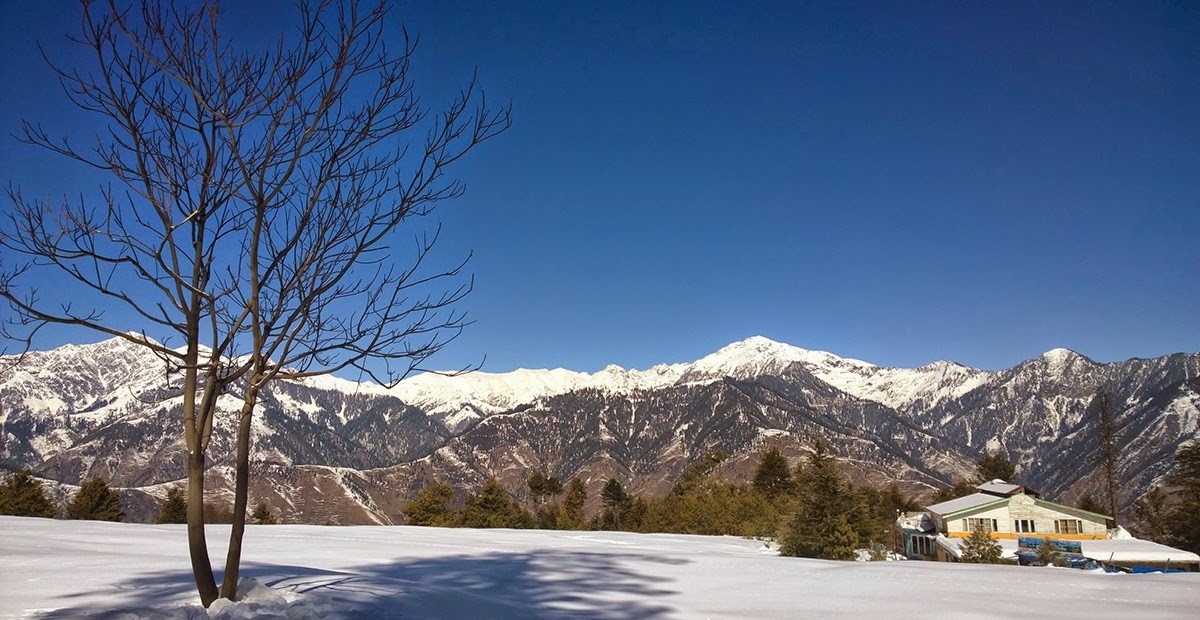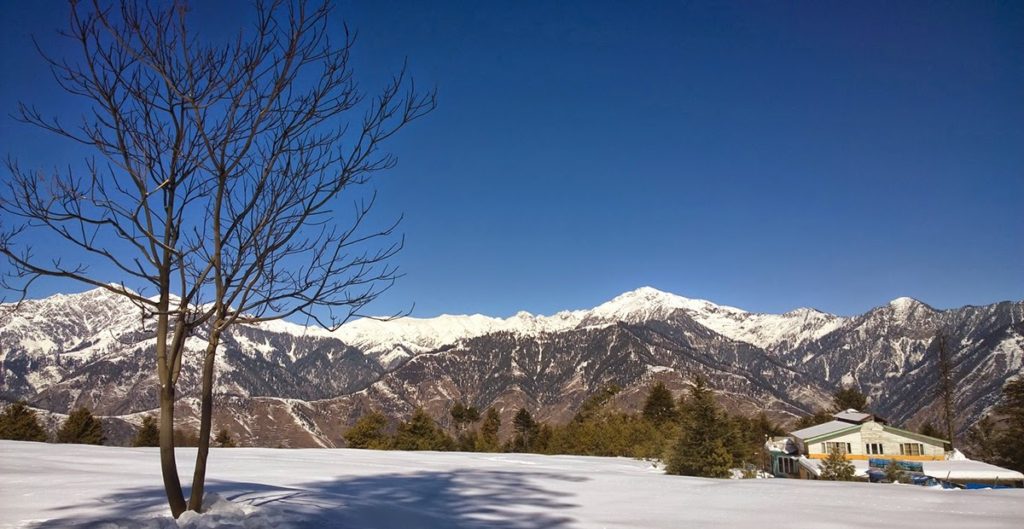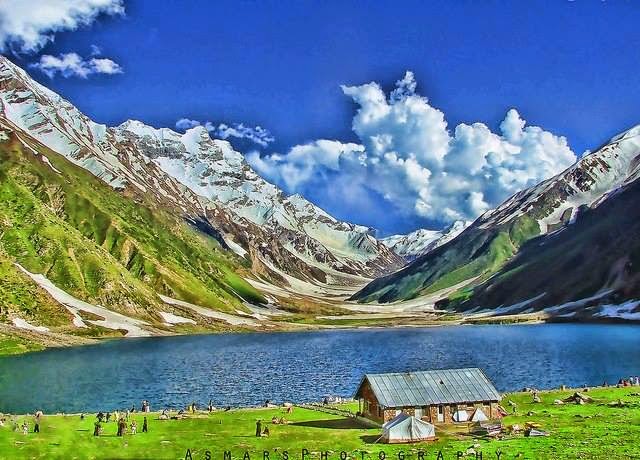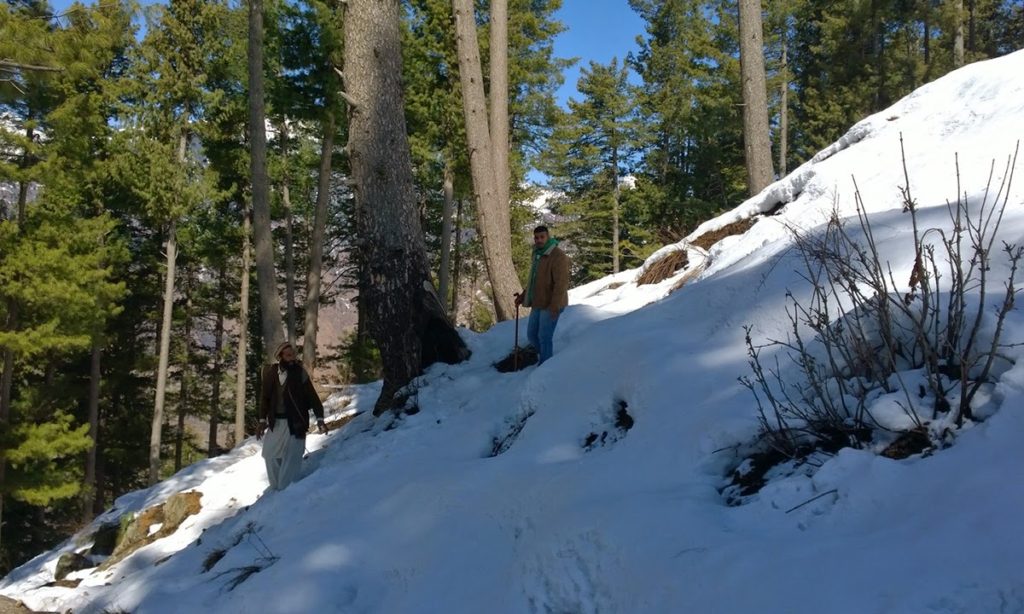Not even the sound of the fan. This was too alien, too scary and too surreal……Balakot …famous battle was fought between the
Sikh Army and Muslim freedom fighters in 1831…..A fairy tale called Saiful Muluk, by Mian Muhammad Bakhsh
…
Kaghan valley lies in the Hazara division of Khyber Pakhtunkhwa. There are beautiful lakes, the river Kunhar (full of brown trout- 7 kilos each!!!) and of course majestic mountains. When we read up a bit we were curious about the fairy tales surrounding lake Saiful Malik and how Islamic fighters fought a brave battle against Sikh imperialists. Plus you have a modern tale of an city-slicker looking for KFC in remote Shogran.
If you wish to travel to yon Gujjar high-lands do plan ahead, travel safely and enjoy the simple charms of bountiful nature that is missing in a megalopolis like Karachi !!!
….
We had
several options: Shogran, Naran, Kalam, Skardu, Gilgit, Chitral, etc.
However, Gilgit, Chitral and Skardu had to be left out due to the time
it would take if we traveled by road (almost seems like going to the
moon,16-24 hours!) and the fact that PIA never ever gives you a
confirmed seat on these routes (they say it’s the weather, I say its
reasons unknown and typical of PIA).
Indecisive yet, we arrived in Islamabad on a cool winter day and went on straight to the bus stop in Rawalpindi.
Unfortunately,
and as luck would have it, we ended up with a scoundrel, who lured us
with his sweet talk and, salivating at the sight of Omani Riyals,
managed to convince us to go to Shogran. “Just four to five hours” away
from Islamabad.
We struck a deal and moved on. I wish I had remembered the famous
saying, “When something is too good to be true, it usually isn’t!” Soon
after we started the trip, the driver got a call from his family, began
shouting at his wife fractiously, got out, heaved our luggage overboard
and simply left us out in the open.
We hired another vehicle; he
ostensibly was on bail after being caught on charges of heroin smuggling
(he blamed the passenger, but we felt otherwise). He seemed a very
devious character and somehow the vibes emanating from him belied his
innocence. I made it a point to be extra wary of him.
We set out again, but soon he started calling someone on phone
continuously. Then, as we somehow had a premonition about, he told us
that because of the excessive snow, we will have to hire a jeep for 6km
(more money) and then walk just 2kms up the mountain (even more money
since we’ll have to hire a porter).
What was so perplexing was
the fact that despite being a seasoned driver he did not know the
conditions at this time of the year.
Two kilometres on paper sound very
achievable, but when it’s climbing a mountain straight up at an incline
of 90 degrees (yes, Shogran has one of the most steep climbs of all
habitable mountains in Pakistan) in freezing temperatures, five feet of
snow, a snap snowstorm and in pitch darkness with wolves, coyotes and
the occasional leopard meowing around you from all nooks and corners,
there is no horror movie that can match the experience.
We were
caught in a situation where we could neither go up because of fatigue
nor could go down. Had it been not for the porter who frolicked on the
rocks like ibexes (and my fast depleting stock of Coke and Red Bull), we
would have definitely died of exposure.
The trip to the top of the mountain took us a good four hours and the
whole experience was reminiscent of my never ending search for a KFC
outlet in Nairobi where whoever I asked only kept telling me that its
“right over there” … and that there turned out to be at least 5km,
which eventually never did come as I had to turn back.
In this
particular situation, our porter cum guide kept pushing us and trying to
show us an imaginary light of the hotel on the horizon, but it seemed
to move further and further away as we walked towards it. Being very
tall and broad in stature, I had a more difficult time walking in the
snow because of my top heavy centre of gravity.
There are just no words to describe the pain and ignominy of slipping over and over again in front of the laughing porter.
Amongst frozen tears and aching bones, we finally saw the hotel, the
last one on the farthest corner of the plateau. We were so tired and
dirty that even if we were asked to pay Rs25,000 per night, I would have
agreed.
However, the euphoria was short lived; the hotel was
hellishly empty, there was no electricity, no warm water and, apart from
the porters, the only living soul was the hotel chowkidar. I could
swear that it was a scene straight out of Stephen King’s classic novel,
The Shining. Salvation came in a different form, though; piping hot tea
(which got cold in a matter of minutes), freshly-cooked parathas and
eggs. But there was still no chance of taking the desperately needed
shower.
When one is feeling as dirty as we were, the whole universe is
limited to addressing that need and nothing else matters. But since
there was no recourse at all, I just lay down to go to sleep as quickly
as possible, all the time cursing my friend.
A technology person,
I felt even more desperate since my mobile phone was not catching
signals, though everyone else’s phones were working! The only heater
they had was a small gas canister which barely served the purpose and
that too we had to turn off before sleeping. That night seemed endless;
the silence, eerie.
Coming from Karachi, we are not used to this.
Not even the sound of the fan. The TV did turn on, replete with Indian
channels, but all I wanted was to go back to Karachi to the comfort of
my home. This was too alien, too scary and too surreal. I woke up often
during the night waiting for morning to come so we can go back and never
see Shogran again.
The morning did come finally, and it was
beautiful. Pristine whiteness all around. Crackingly crisp sun. There
was a brief period when we actually enjoyed the scenery and took some
pictures but that joy too was fleeting as we quickly got tired walking
in the snow; and the thought of embarking on another adventure, i.e.,
going down the mountain, played havoc on our nerves.
It seemed
right out of an RPG game (role playing game) set in medieval Europe,
going downhill over 4,000 feet on foot, made even more complicated by
the fact that the snow had started melting and the terrain had become
even more slippery and muddy.
Surprisingly, it took us longer to go down than to go up since most
of our time was spent in getting up after skidding every 10 feet or so.
The only consolation for next time (if there is a next time) is the
construction of a chairlift which would make this an ideal destination
all year around, maybe even for skiing.
I also marvelled at the
strength of the natives; lean as they were, they still had the strength
of a horse and could have literally carried me down along with our
luggage had the situation come to that. I made sure that I gave them
enough tip for their effort, as that is their only means of sustenance
in winter.
Before we had set out for Shogran, we had excitedly thought of going
to Siri Paya on foot since no jeep or horse is available in winter. One
kilometre up the mountain to Shogran, that wish dissipated quickly. The
thought of walking 7km in snow further 4,000 feet where air is at a
minimum, seemed an almost impossible task.
Driving back to
Abbottabad, we decided to break our journey because I could not take
being that dirty anymore. The hotel we chose was PC (but not the actual
PC). It was good enough though and the only thing that mattered to us
was hot water and a soft bed. We slept like babies and ate at AFC (not
KFC), since there is no foreign food chain in Abbottabad (thank you,
Osama).
Lessons learned from this trip: plan beforehand. Shogran,
you are the most beautiful place on earth. But only if someone was kind
enough to develop you as a winter destination, too. But
then again, when Murree is just a stone throw away from Islamabad, why
go to Shogran in the first place, except only those who are maverick
travelers.
…………..
Balakot: At a distance of 72 km from Abbottabad, Balakot is
the gateway of the Kaghan Valley. It takes about one and half hours
to reach Balakot from Abbottabad, passing through the busy city of
Mansehra. The journey between Mansehra and Balakot is a charming experience.
The black top road winds through beautiful green hills and the thick
forest of Batrasi. Views from Batrasi towards Kaghan Valley are spectacular.
Balakot is a town located on the bank of Kunhar River yet has tremendous
historical significance. A famous battle was fought here between the
Sikh Army and Muslim freedom fighters in 1831. It is here that Hazrat
Syed Ahmed Shaheed and Hazrat Shah Ismail Shaheed sacrificed their
lives here while fighting for the liberation movement.
Shogran:
Shogran, one of the most beautiful plateaus in
the valley, is situated 34 kilometers from Balakot via
Kawai…Surrounded by thick pine forests and with an altitude of
7747 feet,
the summer climate of Shogran is very mild and pleasant. One of the
nicer places to visit is Shoran’s Forest Rest House. From the
rolling
grassy lawns of the rest house, one can become immersed
breathtaking
panoramic views of snow covered mountains. Kaghan Valley’s
highest
peaks, such as Musa Ka Musalla (4419m), Makra (3885m) and Malika
Parbat
(5290m), are visible from here. For those wishing to stay the night
or have a meal, there are a number of hotels in Shogran.
Siri and Payee: A wonderful excursion from Shogran is a visit to Siri
and Payee. A rugged eight kilometer road climbs 9500 feet through thick pine forest to the top of Paya ridge,
a lush green meadow with spectacular view of Malika Parbat. One can
also see varieties of wild alpine flowers on the rolling grassy slopes
of Payee. Visitors can then hike up Makra (Spider) Mountain, which
is 12743 feet from see level.
Siri Lake: A small lake in Siri, on the way to Payee. It is located
an altitude of 8500 feet or 2590 metres approximately.
Payee Lake: Payee Lake is also a small lake located in the centre
of meadow in Payee at the altitude of 9500 feet or 2895 metres
approximately.
Naran: At 7,888 feet above sea level, Naran is the main centre
of tourism in the Kaghan Valley. It is located 82 kilometers from
Balakot. The town is situated on the bank of the Kunhar River at a point
where the valley widens. The river is also quite smooth here and ideal
for trout fishing and easy grade river rafting.
Lake Saiful Muluk: No trip to Kaghan Valley is complete without a visit
to the legendary Lake Saiful Muluk. The lake is named after Prince
Sauful Muluk, who fell in love here with a fairy from the mountains.
At 10,500 feet, Lake Saiful Muluk is surrounded by impressive snow clad
mountains and crowned by the summit of Malika Parbat (Queen of the
Mountains). The highest peak in Kaghan Valley, the majestic Malika Parbat
has a height of 5291 metres.
A fairy tale called Saiful Muluk, written by the famous Sufi poet Mian Muhammad Bakhsh, is associated with the lake. It is the story of the prince of Persia who fell in love with a fairy princess.
The impact of the lake’s beauty is of such extent that people believe
that fairies come down to the lake in the full moon. A poet and writer
from Balakot Dr Mujahid Hussain wrote the story of Saiful Muluk in prose depicting the local version.
Naran to Babusar Pass: For the thrilling experience of Babusar Pass, one must
wait until mid July, when the road from Jalkhad onward become accessible.
With a height of 13,687 feet (4,173 metres) Babusar Pass creates the border between the Kaghan Valley
and the Chilas regions. From the top of Babusar Pass one may behold a
panoramic view of snow-covered peaks and sweeping valleys.
The British built a pony track across the Babusar in
1892 to give access to Gilgit. Before this, the only route to Gilgit
was from Srinagar across the Burzil Pass; until the building of
Karakuram Highway, the track was the main route to Chilas and Gilgit.
Today, jeeps to Babusar can be hired from Naran….A stone cairn marks the highest point of the pass. From the stone
cairn marking the highest point of the pass, many take the time to enjoy
the gorgeous vistas surroundings Kaghan and Babsar Valleys and the white
topped snowy mountains in the backdrop. Chilas town is 50 kilometers
from here. From Chilas one can go towards Gilgit, Hunza, Skardu and other
valleys of Northern Areas.
How to Reach Kaghan Valley: It takes four hours to reach Balakot, the gateway town
of Kaghan Valley traveling on good black top road via Abbottabad
and Mansehra….From mid May onward the road to Naran is open for regular cars,
vans and coaches. If you are driving, always start early in the morning
to safely reach your destination well before dark. For those preferring public
transport, travel by air conditioned bus service is an option. There are
several bus companies with regular direct service to Balakot from Lahore
and Rawalpindi. PTDC operates daily air conditioned bus service to Naran
from Flashman’s Hotel in Rawalpindi at 9.00 am. Bookings can be made by
calling at 051-9272017 and 9272004. There are plenty of private jeeps for
hire at Balakot, Kewai, Shogran, Kaghan, and Naran to go on various day
trips.
When to Go: Tourist season in the Kaghan Valley begins in mid May
and closes in mid October. The summer climate (June to September)
is ideal, with maximum temperatures of 20 C and minimum temperatures
of 5 C. The road beyond Naran is snowbound in winter, yet from late
June to late October, it remains open all the way to Babusar Pass. The
best time to cross the Babusar Pass is late July or August. Mid July
to Mid August is monsoon season and vehicle movement is sometimes restricted
due to landslides and rains in the lower Kaghan Valley.
…..
Link(1): http://www.dawn.com/news/1116761/travel-pakistan-visiting-shogran-in-winter
Link(2): http://pakistanexpress.tripod.com/
…..
regards




